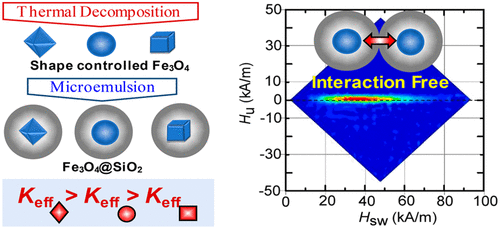Our official English website, www.x-mol.net, welcomes your
feedback! (Note: you will need to create a separate account there.)
Estimation of Magnetic Anisotropy of Individual Magnetite Nanoparticles for Magnetic Hyperthermia.
ACS Nano ( IF 15.8 ) Pub Date : 2020-06-23 , DOI: 10.1021/acsnano.0c02521 Hiroaki Mamiya 1 , Hiroya Fukumoto 2 , Jhon L Cuya Huaman 2 , Kazumasa Suzuki 2 , Hiroshi Miyamura 2 , Jeyadevan Balachandran 2
ACS Nano ( IF 15.8 ) Pub Date : 2020-06-23 , DOI: 10.1021/acsnano.0c02521 Hiroaki Mamiya 1 , Hiroya Fukumoto 2 , Jhon L Cuya Huaman 2 , Kazumasa Suzuki 2 , Hiroshi Miyamura 2 , Jeyadevan Balachandran 2
Affiliation

|
Ideal interaction-free magnetite nanoparticles were prepared, and their magnetic properties were measured to clarify the true nature of magnetic anisotropy of individual magnetite nanoparticles at the nanoscale and to analyze the shape, surface, and crystalline anisotropy contributions. Spherical (17.7 nm), cubic (10.6 nm), and octahedral-shaped magnetite nanoparticles with average sizes ranging from 7.6 to 23.4 nm were synthesized using solution techniques. Then, these nanoparticles were coated with silica at appropriate shell thicknesses to prepare magnetic interaction-free samples, and their noninteractive nature was confirmed through first-order reversal curve diagrams. For these well-isolated nanoparticles, remanent magnetizations of the hysteresis loops are just equal to a half of the saturation magnetization. This result clearly indicates that uniaxial magnetic anisotropy is predominant in each nanoparticle. In order to clarify the details of the uniaxial magnetic anisotropy, the analysis of blocking temperature–switching field distribution diagrams is constructed based on thermal decay curves of isothermal remanent magnetization at various applied fields. The obtained effective magnetic anisotropy constant Keff is distributed around 10–20 kJ/m3 and has insignificant size dependence. This result seems inconsistent with the inverse proportion relation of Keff with size predicted for surface magnetic anisotropy. The theoretical calculation suggested that the crystalline magnetic anisotropy plays a major role in magnetic properties of the magnetite nanoparticles at lower temperatures. However, it should be noted that Keff seems slightly different for the different shapes. The above study indicates that control size, shape, and interparticle interactions is required to strictly discuss such delicate differences of magnetic anisotropy of individual magnetite nanoparticles for the design of thermal seeds for magnetic hyperthermia.
中文翻译:

磁热疗中单个磁铁矿纳米粒子的磁各向异性估计。
制备了理想的无相互作用的磁铁矿纳米颗粒,并对其磁性进行了测量,以阐明单个磁铁矿纳米颗粒在纳米尺度上的磁各向异性的真实性质,并分析了形状,表面和晶体各向异性的贡献。使用溶液技术合成了球形(17.7 nm),立方(10.6 nm)和八面体形状的磁铁矿纳米颗粒,平均粒径为7.6至23.4 nm。然后,将这些纳米粒子以适当的壳厚度涂覆二氧化硅,以制备无磁性相互作用的样品,并通过一阶反转曲线图确认其非相互作用性质。对于这些良好隔离的纳米粒子,磁滞回线的剩余磁化强度仅等于饱和磁化强度的一半。该结果清楚地表明,在每个纳米颗粒中单轴磁各向异性是主要的。为了阐明单轴磁各向异性的细节,基于等温剩余磁化强度在各个应用场上的热衰减曲线,构建了阻塞温度切换场分布图的分析。获得的有效磁各向异性常数K eff分布在10–20 kJ / m 3左右,并且与大小无关。该结果似乎与K eff与表面磁各向异性预测的尺寸的反比例关系不一致。理论计算表明,结晶磁性各向异性在较低温度下对磁铁矿纳米颗粒的磁性能起主要作用。但是,应该指出的是,ķ EFF对于不同的形状似乎有些不同。以上研究表明,为了严格设计单个磁铁矿纳米颗粒的磁各向异性的微妙差异,需要设计尺寸,形状和颗粒间相互作用,以便设计用于磁热疗的热晶种。
更新日期:2020-07-28
中文翻译:

磁热疗中单个磁铁矿纳米粒子的磁各向异性估计。
制备了理想的无相互作用的磁铁矿纳米颗粒,并对其磁性进行了测量,以阐明单个磁铁矿纳米颗粒在纳米尺度上的磁各向异性的真实性质,并分析了形状,表面和晶体各向异性的贡献。使用溶液技术合成了球形(17.7 nm),立方(10.6 nm)和八面体形状的磁铁矿纳米颗粒,平均粒径为7.6至23.4 nm。然后,将这些纳米粒子以适当的壳厚度涂覆二氧化硅,以制备无磁性相互作用的样品,并通过一阶反转曲线图确认其非相互作用性质。对于这些良好隔离的纳米粒子,磁滞回线的剩余磁化强度仅等于饱和磁化强度的一半。该结果清楚地表明,在每个纳米颗粒中单轴磁各向异性是主要的。为了阐明单轴磁各向异性的细节,基于等温剩余磁化强度在各个应用场上的热衰减曲线,构建了阻塞温度切换场分布图的分析。获得的有效磁各向异性常数K eff分布在10–20 kJ / m 3左右,并且与大小无关。该结果似乎与K eff与表面磁各向异性预测的尺寸的反比例关系不一致。理论计算表明,结晶磁性各向异性在较低温度下对磁铁矿纳米颗粒的磁性能起主要作用。但是,应该指出的是,ķ EFF对于不同的形状似乎有些不同。以上研究表明,为了严格设计单个磁铁矿纳米颗粒的磁各向异性的微妙差异,需要设计尺寸,形状和颗粒间相互作用,以便设计用于磁热疗的热晶种。











































 京公网安备 11010802027423号
京公网安备 11010802027423号